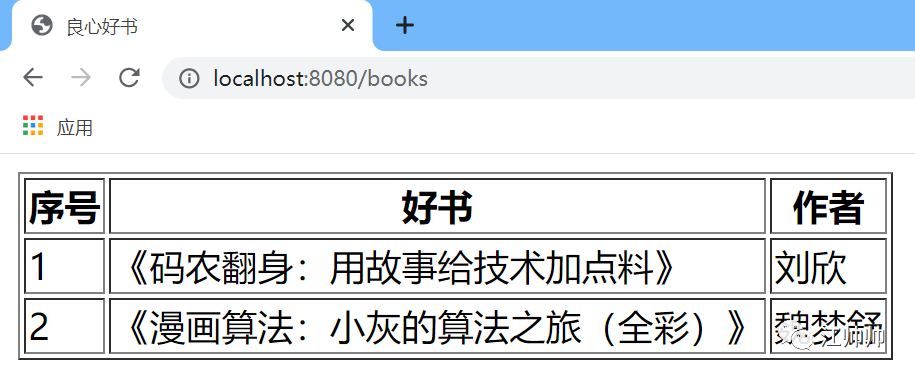- Web 開發的支持
使用 Spring Boot 實現 Web 開發更加便捷了,因為直接依賴 spring-boot-starter-web 模塊即可支持 Web 開發,此模塊預定義了 Web 開發中常用的依賴包,還有內嵌的 Tomcat 作為默認 Web 容器。
- Thymeleaf 模板引擎
目前,多數企業級應用開發中都支持前後端分離,但還有少數離不開視圖層技術,Spring Boot 提供了很多模板引擎來支持視圖層技術,比如 Thymeleaf、Freemarker、Velocity。
Thymeleaf 是官方推薦使用的新一代 Java 模板引擎,並支持 HTML 原型,模板表達式在脫離運行環境下不汙染 HTML 結構,能讓前端直接通過瀏覽器查看基本樣式,也能讓後端使用真實數據查看展示效果。
- 整合使用 Thymeleaf 模板
3.1. 創建工程
創建一個 Spring Boot 工程,編輯 pom.xml 文件,添加 web 和 thymeleaf 依賴。另外,App 啟動類與之前一致。
<dependency>
<groupId>org.springframework.boot</groupId>
<artifactId>spring-boot-starter-web</artifactId>
</dependency>
<dependency>
<groupId>org.springframework.boot</groupId>
<artifactId>spring-boot-starter-thymeleaf</artifactId>
</dependency>3.2. 添加視圖文件
在 src/main/resources/templates 目錄下,新建 nicebook.html 文件。
<head>
<meta charset="UTF-8">
<title>良心好書</title>
</head>
<body>
<table border="1">
<tr>
<td>序號</td>
<td>好書</td>
<td>作者</td>
</tr>
<tr th:each="book:${books}">
<td th:text="${book.id}"></td>
<td th:text="${book.name}"></td>
<td th:text="${book.author}"></td>
</tr>
</table>
</body>3.3. 配置 Thymeleaf
如果想自定義 Thymeleaf 配置參數,可以在 application.properties 文件中進行配置,常見的配置選項如下:
模板文件存放位置
spring.thymeleaf.prefix=classpath:/templates/
是否開啟緩存,默認為 true,開發時可設置為 false
spring.thymeleaf.cache=true
檢查模板位置是否存在,默認為 true
spring.thymeleaf.check-template-location=true
檢查模板是否存在,默認為 true
spring.thymeleaf.check-template=true
模板文件後綴設置
spring.thymeleaf.suffix=.html
模板文件編碼設置
spring.thymeleaf.encoding=UTF-8
Content-Type 配置
spring.thymeleaf.servlet.content-type=text/html
3.4. 創建 POJO
public class Book {
private Integer id;
private String name;
private String author;
// getter 和 setter 方法}
3.5. 創建 BookController 控制器
@Controller
public class BookController {
@GetMapping("/books")
public ModelAndView books() {
List<Book> bookList = new ArrayList<>()
Book book1 = new Book();
book1.setId(1);
book1.setName("《碼農翻身:用故事給技術加點料》");
book1.setAuthor("劉欣");
Book book2 = new Book();
book2.setId(2);
book2.setName("《漫畫算法:小灰的算法之旅(全綵)》");
book2.setAuthor("魏夢舒");
bookList.add(book1);
bookList.add(book2);
ModelAndView mv = new ModelAndView();
mv.addObject("bookList");
mv.setViewName("nicebook");
return mv;
}}
3.6. 運行測試
瀏覽器中訪問:http://localhost:8080/books,即可看到如下頁面。

- Thymeleaf 的支持
Spring Boot 通過 org.springframework.boot.autoconfigure.thymeleaf 包為 Thymeleaf 提供了自動配置,涉及到的類如下:

其中 ThymeleafAutoConfiguration 和 ThymeleafProperties 類是比較重要的,前者對集成所需要的 Bean 進行自動配置,後者主要讀取 application.properties 配置文件,可自定義 Thymeleaf 的屬性和默認配置。
ThymeleafProperties 類部分源碼如下:
@ConfigurationProperties(
prefix = "spring.thymeleaf")
public class ThymeleafProperties {
private static final Charset DEFAULT_ENCODING;
public static final String DEFAULT_PREFIX = "classpath:/templates/";
public static final String DEFAULT_SUFFIX = ".html";
private boolean checkTemplate = true;
private boolean checkTemplateLocation = true;
private String prefix = "classpath:/templates/";
private String suffix = ".html";
private String mode = "HTML";
private Charset encoding;
private boolean cache;
private Integer templateResolverOrder;
private String[] viewNames;
private String[] excludedViewNames;
private boolean enableSpringElCompiler;
private boolean renderHiddenMarkersBeforeCheckboxes;
private boolean enabled;
private final ThymeleafProperties.Servlet servlet;
private final ThymeleafProperties.Reactive reactive;
... }
- 拓展:Thymeleaf 常用語法
5.1. 使用 URL
通過 @{…} 來處理常見 URL。
http://www.naixuejiaoyu.com}">奈學教育
5.2. 使用表達式
主要用來從模板中的 WebContext 獲取param、request、session 和 application 中的屬性。使用 ${x} 即可返回存儲在 Thymeleaf 上下文中的變量 x 或作為 request 作用域中的屬性。
${param.x} 能夠返回名為 x 的請求參數;
${session.x} 能夠返回名為 x 的 HttpSession 作用域中的屬性;
${application.x} 能夠返回名為 x 的 ServletContext 作用域中的屬性。
5.3. 使用字符串
如果需要對一段文字中的某一處進行替換,可以使用 |…| 這種便捷方式,但不能包含其他常量、條件表達式,只能包含變量表達式 x即可返回存儲在Thymeleaf上下文中的變量x或作為request作用域中的屬性。¨G7G¨K25K如果需要對一段文字中的某一處進行替換,可以使用∣…∣這種便捷方式,但不能包含其他常量、條件表達式,只能包含變量表達式{…},有一定侷限性。
5.4. 使用運算符
平時看到的算術運算符和邏輯運算符都可以使用。
5.5. 使用條件判斷
可以使用 th:if 和 th:unless 屬性進行條件判斷,前者條件成立時顯示,後者不成立時才顯示。也可以使用 Switch 結構,默認選項使用 * 來表示。
<p th:case="'Java'">Java 從入門到逃難</p>
<p th:case="'Python'">Python 從入門到逃難</p>5.6. 使用循環
使用 th:each 即可實現循環。
<td th:text="${book.id}"></td>
<td th:text="${book.name}"></td>
<td th:text="${book.author}"></td>5.7. 使用內置對象
通過 # 可以直接訪問 Thymeleaf 的內置對象。
dates:日期
calendars:日曆
numbers:數值格式化
strings:字符串格式化
objects:對象
maps:Map 操作工具
aggregates:操作數組或集合的工具
bools:布爾
sets:Set 操作工具
messages:消息
arrays:Array 操作工具
lists:List 操作工具
來源於:奈學開發者社區-江帥帥